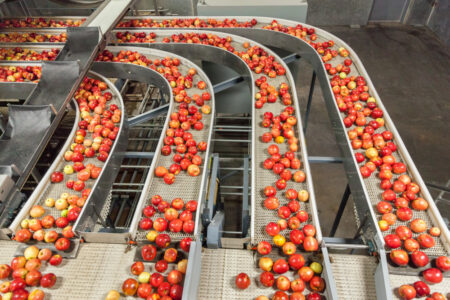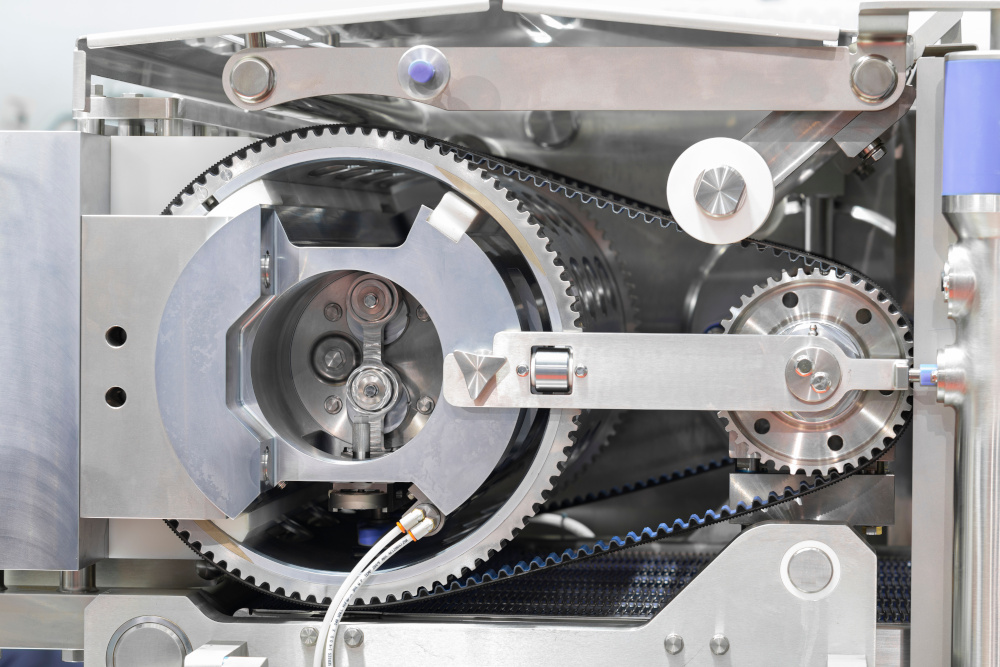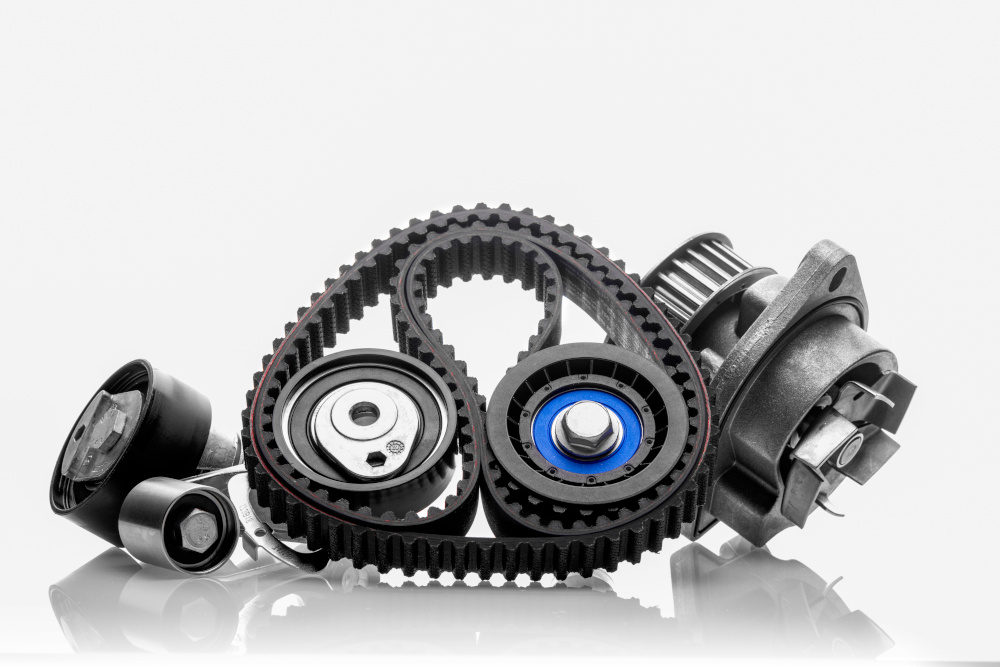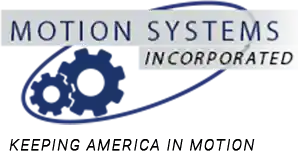
The Essential Guide to Custom Pulleys
Table of contents
Often underestimated, pulleys are critical in many applications, from the precise positioning required in high-tech machinery to the brute force needed in heavy industrial equipment. A well-chosen pulley isn’t just a part—it’s a solution to a mechanical challenge, ensuring that everything runs like clockwork.
Whether it’s mitigating the risk of a timing belt slip in an automotive application or ensuring the seamless movement of a conveyor belt, the right pulley can dramatically impact the performance and longevity of a system.
In this guide, we’ll discuss the many types of pulleys and their specific benefits and uses.
The Mechanics of Pulleys

Before we get into the different types of pulleys, let’s talk about how they work and their diverse roles within mechanical drive systems.
At its core, every pulley and belt system is about transmitting power. It begins at a power source, which could be anything from the diesel engine in a pickup to an industrial electric motor to your own legs on a bicycle. That power is converted into rotational energy at the driver (dR) pulley. It is then transmitted via a belt or roller chain to another pulley or series of pulleys, known as driven (dN) pulleys. A familiar example of this is an automobile’s serpentine belt system. In this type of system, the engine generates energy, which is transformed into rotational energy at the crankshaft pulley. This energy is then distributed to various components like the alternator, power steering, A/C, and water pump via the serpentine belt where it is then used to do things such as charge the battery, multiply the force from the steering wheel, run a compressor to cool air for the occupants, and rotate a pump to draw coolant through the engine.
More About dR & dN Pulleys
A crucial aspect of pulley systems is the mechanical advantage achieved by varying the size difference between the dR and dN pulleys. If the dN pulley is smaller than the dR pulley, it spins faster than the motor but produces less torque. Conversely, if the dN pulley is larger, it spins slower but generates more torque. This principle is exemplified in mountain bikes. When you pedal (acting as the motor), the sprocket at the pedals (dR) transmits power to the sprocket at the rear wheel (dN). Starting from a stop requires more torque, so a larger dN gear is used. As you gain momentum and shift gears, the dN sprocket size decreases, changing the output from high torque and low speed to high speed and low torque.
The applications of this power transmission are incredibly diverse. In some cases, it’s as simple as moving power from one shaft to another, driving devices like compressors, turbines, generators, fans, and other industrial tools. However, pulleys can also transform this power in unique ways, such as in positioning, conveying, or synchronizing tasks.
Positioning
Positioning applications, like 3D printers, transform rotational energy from a motor to move a printer head precisely. Here, three drives (one from each axis) usually work together.

Conveying
In conveying applications, the power from a motor moves a conveyor belt to transport objects, whether in agricultural settings, waste management, or production lines.
Synchronization
Lastly, in synchronization tasks, such as with a car’s timing belt, the focus isn’t on transmitting power per se but on keeping multiple shafts (like the crankshaft and camshaft) timed to their rotations. This synchronization is crucial for the engine’s proper functioning.
Sprockets & Sheaves
Sprockets and sheaves are integral to pulley systems. They’re also not interchangeable, so it’s important for you to understand the differences between them.
Sprockets

Sprockets, often associated with gearbelt pulleys, are characterized by their distinct tooth-like projections, which mesh perfectly with the links of a chain or gearbelt. These teeth (on a roller chain sprocket) or grooves (on a gearbelt pulley) are meticulously manufactured to ensure a precise fit, eliminating any slip between the sprocket and the belt or chain. The material the sprocket is made from, usually metals like steel or aluminum, is chosen based on the application’s specific needs and balancing factors like strength, weight, wear resistance, and cost.
Applications
Sprockets and gearbelt pulleys are commonly found in applications where high torque at low RPM is required, such as industrial dough mixers, aggregate elevators and conveyors, and agricultural equipment.
They are also often used in settings where timing is essential, like automobile engines. Here, the timing pulleys and belts play a critical role in synchronizing the movement of the engine’s valves and pistons, ensuring efficient operation.
Sprockets also allow for precision motion control and so are integral to various machinery used in manufacturing and processing, including robotics and automated assembly lines.
Benefits
The primary advantage of sprockets is their ability to transmit huge amounts of torque at LOW RPMS and to maintain precise alignment and timing, reducing the risk of slippage and misalignment. Sprockets are also highly customizable, as they can be designed with specific numbers of teeth and sizes to suit different applications. Their robust construction also makes them highly durable and well-suited to high-stress environments.
Sheaves

Next, sheaves are designed to accommodate v-belts and are characterized by their v-grooved circumference. These grooves are customized to match the cross-section of a v-belt and allow friction-based transfer of power, with the v-belt wedged securely in the sheave’s grooves. Like sprockets, the material choice for sheaves is usually metal but can also include composites and plastics, depending on the application’s requirements.
There are many types of sheaves, but one common type is the companion sheaves, which plays a crucial role in variable speed drives. In these systems, the dR pulley can vary its diameter through various mechanical means. Its ability to vary its diameter, combined with an adjustable center distance between the dR and dN shafts, allows for changes in the output speed at the dN pulley. In this context, the companion sheave, which is the dN pulley, remains non-adjustable. It works with the adjustable dR pulley to facilitate the desired speed variation.
Applications
V-belt sheaves are ubiquitous, coming in virtually every shape and size from the common automotive fan belt drive to massive rock-crusher applications found in mines and quarries. Many office building air-handling systems use sheaves and v-belts as well as smaller applications, such as air compressors, drill presses, and table saws.They also are widely used in the powersports industries where you find variable pitch sheaves.
Benefits
Sheaves are beneficial because they can transmit power efficiently through friction, providing a reliable and steady drive. This friction-based transfer allows for some slip, which can be advantageous in applications where shock-loading or variable load conditions are present.
Sheaves are also relatively easy to install and maintain and are available in a huge variety of configurations, often making them the most cost-effective option.
Specialized & High-Precision Pulleys
The first type of pulleys we’ll cover are those meticulously engineered for high-precision, high-torque, and high-speed applications, or applications that require ease of installation and maintenance.
High-Precision (Zero-Backlash)
High-precision pulleys are highly needed in applications where timing and positioning accuracy are critical. The primary type of high-precision pulley is anti- and zero-backlash.
Anti- & Zero-Backlash Pulleys
Anti- and zero-backlash pulleys are important in applications where accuracy is critical, and even the slightest timing slip can lead to significant consequences. A classic example is the timing belt in a car, where precise synchronization of sprockets is essential for maintaining engine health—any deviation here can result in catastrophic engine failure. This need for precision also extends beyond automotive applications.
For example, in linear motion systems, such as the extruder unit on a 3D printer, the accuracy in movement and positioning becomes increasingly vital as technology advances. The underlying challenge in these applications is backlash—the slight rocking or unintended movement when a drive starts or stops, caused by a small gap or ‘slop’ between the belt teeth and sprocket grooves.
Addressing this issue involves tightening the tolerance between the belt and pulley, a solution known as anti-backlash or zero-backlash.
Additional Considerations for High-Precision Pulley Applications
This solution can be further refined by selecting the appropriate type of belt, considering its profile and construction for precision, and opting for the most suitable pulley mounting method, such as keyed versus keyless bushings or slip fit versus shrink fit bores.
Additionally components, like sprockets and gears can be designed to achieve zero backlash because the gear teeth and sprocket grooves are precisely engineered to fit together with minimal clearance.
High-Torque (Spline-Bore)

High-torque pulleys, particularly those with spline-bore design, are needed in heavy-load applications to ensure reliable power transmission.
Spline-bore pulleys feature a toothed design, which ensures an even distribution of torque across the bore and shaft, reducing metal fatigue and resulting in higher torque capacities and prolonged component life, even at increased speeds.
Additional Considerations for High-Torque Pulley Applications
Another way to ensure reliable power transmission in high-torque applications is to have durable pulley components. For example, Motion Systems manufactures sprockets with oversized bushings or bores specifically designed to handle increased torque capacities. And to combat belt side-tracking forces in heavy-duty drives, which can make short work of stock flanges, we offer extra-thick, heavy-duty flanges that can either be welded or bolted on.
High-torque pulley applications often require components made from stronger materials, like high-grade steel or specialized alloys, that can withstand the high levels of stress and torque in these applications. These materials are less likely to deform, crack, or wear under extreme conditions, ensuring the longevity of the pulley system. A tough application might call for a made-to-order solution, such as having a pulley that is cast-iron off-the-shelf made instead from a high-strength steel.
Lastly, even high-strength steels sometimes need help to survive applications where they encounter corrosive washdowns or airborne particulates that can wear the groove surface. For those applications, sprockets can be toughened through a variety of finishes, such as heat-treat, hard anodizing, or carburizing.
High-Speed (Dynamic Balancing)

In high-speed applications, pulleys will need to be dynamically balanced. Like the balancing of car and truck tires, but with much greater precision, dynamic balancing of sprockets ensures that vibrations caused by unbalance are minimized, reducing component fatigue.
Additionally, high-speed drives operate under conditions that place immense stress on the sprocket as it rotates at high speeds. Under these extreme conditions, conventional materials like standard steel can pose grave safety risks. The centrifugal force exerted at such high speeds can cause the metal to fragment, creating a situation akin to a grenade explosion. With that in mind, it’s important that these pulleys are made from higher tensile strength steel or materials with a lower rotating mass, like aluminum.
Ease of Installation & Maintenance (Split)
The last type of specialty pulley is a split pulley, which is specifically designed for easy installation in unique applications.
As the name suggests, these pulleys are literally split or cut in half. The design is not a manufacturing quirk—it serves a very practical purpose. In many mechanical systems, especially those with limited space or complex configurations, installing a traditional, one-piece pulley can be a significant challenge, particularly when the desired location of a pulley on a shaft doesn’t have an open end to slide the pulley onto.
To overcome this challenge, split pulleys are designed to be assembled directly around the shaft. Each half of the pulley is positioned around the shaft at the intended location and then bolted together, eliminating the need for access to the end of the shaft.
Additionally, in systems where regular maintenance is required or in situations where pulley replacement might be necessary, the split design allows for the pulley to be removed and replaced quickly and easily, without the need for extensive disassembly of the surrounding components.
Additional Considerations for Applications Requiring Easy Installation & Maintenance
In mechanical systems where easy installation and maintenance are key, bolt-on flanges and kitting also play transformative roles.
Bolt-on flanges, for instance, are particularly beneficial in applications with limited installation adjustment range. These flanges can be conveniently removed to allow the belt to be slid onto the sprocket and then reattached, streamlining the installation process and making future maintenance or belt replacement more straightforward.

Additionally, installing a drive system involves multiple components—at the very least, two sprockets and a belt. Additional components like bushings (if the sprockets aren’t bored to size), idlers, and mounting brackets are often required. Traditionally, sourcing these parts from different suppliers can be a logistical headache, sometimes resulting in mismatched orders, lost shipments, or out-of-stock parts.
Kitting, which Motion Systems offers, is a way to alleviate these challenges, as it’s a single, comprehensive packaging containing every necessary component for, in this scenario, a drive installation. This approach means customers can order a single SKU and receive all the parts in one consolidated package. Kitting can also be tailored to meet specific aesthetic requirements, with parts being painted or finished to match.
Other Types
Beyond specialized pulleys for high-precision, high-torque, high-speed, and other unique applications, there are other custom pulley options that cater to a broader range of needs, including idler, flat belt, and cable/wire rope.
Idler
Idler pulleys come in various designs tailored to their specific roles in a drive system. They can be classified broadly into two types: Inside and Outside/Backside.
Inside
These are typically positioned within the belt loop and are primarily used to take up slack in the system. Belts require a significant amount of tension to operate effectively, and inside idlers help maintain this tension, especially in systems with insufficient or no adjustment to move the dR or dN pulleys closer together or farther apart.
Some inside idlers are spring-loaded, a common feature in automotive applications, allowing for automatic adjustment of tension. Others are static-mounted, more frequently seen in industrial applications.
Outside/Backside

Positioned on the outside of the belt loop, these idlers help manage slack and increase ‘wrap’ on the pulley. Wrap refers to the amount of the pulley’s circumference that is in contact with the belt. Ensuring adequate wrap is critical, as insufficient contact can lead to the belt slipping or jumping teeth, resulting in power loss or synchronization issues. This is particularly important in systems where there’s a significant difference in the diameters of the pulleys.
Applications
Idlers are found across all belt and roller chain applications, though are not required on every drive. Just as with sprockets and sheaves, sometimes a custom solution is required, and that’s when pairing with a trusted expert like Motion Systems can be helpful.
Customization
At Motion Systems, the pulleys we manufacture are often larger, more robust, and always catered to the unique requirements of various drives. On larger drives, a stock idler may not exist, but we can help you build one.
We can also provide idlers made from stainless steel with stainless steel bearings to survive the most demanding environments.
Flat Belt

Unlike their toothed or grooved counterparts, flat belts have a smooth, flat surface. While not conducive to transmitting high torque levels, this design is ideal for certain high-speed and long-distance applications. One of the key design features of pulleys used with flat belts is that they are crowned in the middle. This crowning helps keep the belt centered and prevents it from tracking off the edge. This feature is particularly beneficial in systems where the belt alignment might not be perfect or where the belt runs over a long distance and may tend to wander.
Applications
Flat belts are commonly used in conveyor systems, where their ability to run over long distances is a significant advantage. They are also found in classic steam engines, driving the flywheel, and in smaller household appliances like vacuum cleaners.
Despite their utility, flat belts have become less common in modern machinery, largely replaced by more advanced belts capable of handling higher torque. However, their use in specific applications like conveyors and treadmills keeps them relevant in certain sectors.
Cable & Wire Rope

As the name suggests, these pulleys are engineered to work with steel cables or wire ropes and are ideal for applications where tensile strength and flexibility in alignment are crucial.
Unlike belt-driven systems, cable and wire rope pulleys need to handle materials that are not only strong but also potentially abrasive. So, cable and wire rope pulleys are often made from materials that can withstand significant wear and tear. Additionally, the groove of the pulley is designed to match the diameter and texture of the cable or rope, ensuring a secure grip and smooth operation.
A key feature of these pulleys is their ability to function effectively when there’s little or no alignment between the driver and driven pulleys. This aspect is particularly important in systems where the driven pulley is mounted on a rotating shackle, allowing for a wide range of motion and flexibility in the system’s configuration.
Applications
Cable and wire rope pulleys are found in large garage doors, which help smooth the lifting and lowering of heavy doors and bear the weight and tension of the steel cables. They’re also found in gym equipment like cable machines, where they guide and support the steel cable that users pull against. They’re also commonly found on tow trucks and shackle blocks for winches and other pulley applications requiring heavy load handling and high tension.
Materials & Coatings
Although each application requires a specific type of pulley, material choice and coatings are also crucial because they directly impact the performance and durability of the pulley. The choice of material and coating for a pulley is determined by the application’s specific requirements, including environmental conditions, load capacity, wear resistance, and compliance with industry standards.
Here is a breakdown of some of the most common materials and coatings used:

- Steel: Basic steel offers high strength and durability, making it suitable for heavy-duty applications. Steel is often used in industrial environments because of this.
- Stainless Steel: Stainless steel is known for its corrosion resistance, making it ideal for harsh environments or applications where hygiene is a priority, like in the food and beverage industry.
- Aluminum: Lightweight and corrosion-resistant, aluminum is preferred in applications where weight is a concern, like in the automotive sector.
- Cast Iron: Cast iron exhibits excellent wear resistance and vibration-dampening properties, making it suitable for heavy industrial applications.
- Food-Grade Materials: These materials are required in industries where the pulley comes into contact with food products. In these cases, the pulley needs to meet certain standards for safety and cleanliness.
- Ductile Iron: This type of iron combines steel’s strength with iron’s castability, offering good wear resistance and toughness.
- Delrin®: This type of thermoplastic is known for having high strength and stiffness, low friction, and good wear properties.
- Nylon: This versatile plastic is known for its wear resistance, low coefficient of friction, and good fatigue life.
- Phenolic: Phenolic is a hard, dense material made from synthetic resin. It’s known for its excellent electrical insulating properties.
- Brass: Brass offers good corrosion resistance and is often used in decorative applications.
- Bronze: Bronze is known for its strength and corrosion resistance. It’s often used in more specialized, seawater applications.
- Monel®: This is a nickel-copper alloy known for its exceptional corrosion resistance.
Coatings

- Nickel: A nickel coating provides a hard, wear-resistant surface, enhancing the pulley’s durability and corrosion resistance.
- Clear or Hard Anodizing (for Aluminum): This coating increases aluminum’s corrosion and wear resistance but can also be used for aesthetic purposes.
- Food Grade Finishes: These finishes are non-toxic, safe for contact with food, and easy to clean, making them essential in food processing applications.
- Zinc: Zinc coatings are commonly used for steel, providing good corrosion resistance and a shiny finish.
- Black Oxide: This type of coating is more about aesthetics and minimizing glare, although it does offer mild corrosion resistance.
- Painting: Standard paint coatings provide a layer of protection against corrosion and can be used for color-coding, safety, or branding purposes.
- Powder Coating: Powder coats offer a durable and corrosion-resistant finish that is thicker and more resilient than regular paint.
- Chrome Plating: Chrome plating provides a high-gloss finish with excellent corrosion resistance and increased surface hardness.
Learn More From Motion Systems
Many people don’t realize how complex pulleys are. Selecting the wrong type will lead to inefficient power transmission, increased wear and tear on both the pulley and the belt, and a heightened risk of mechanical failure.
Many people also don’t realize how many solutions exist to unique power transmission challenges. That’s why Motion Systems is committed to designing and engineering the perfect solutions for our customers. We manufacture all types of custom pulleys, including idler, flat belt, split, and step, and offer a wide array of material and coating options. All parts we manufacture are made in America, and we offer expediting options to meet your needs.
Please contact us today to learn more about our capabilities or to request a quote.
